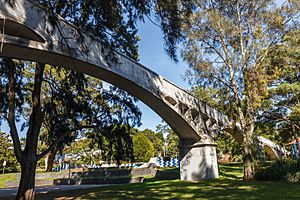White's Creek Aqueduct facts for kids
Quick facts for kids White's Creek Aqueduct |
|
|---|---|

White's Creek Aqueduct viewed from the north side.
|
|
| Location | Piper Street, Lilyfield, Inner West Council, Sydney, New South Wales, Australia |
| Built | 1897–1898 |
| Architect | William Julius Baltzer (Public Works Department) |
| Owner | Sydney Water |
| Official name: White's Creek Aqueduct; Whites Creek Aqueduct | |
| Type | state heritage (built) |
| Designated | 18 November 1999 |
| Reference no. | 1354 |
| Type | Sewage Aqueduct |
| Category | Utilities - Sewerage |
| Builders | Public Works Department |
| Lua error in Module:Location_map at line 420: attempt to index field 'wikibase' (a nil value). | |
The White's Creek Aqueduct is a special bridge in Lilyfield, Sydney, Australia. It was built a long time ago, between 1897 and 1898. This aqueduct was designed by an engineer named William Julius Baltzer. It's owned by Sydney Water and is listed on the New South Wales State Heritage Register because it's an important part of history.
Contents
Building Sydney's Sewer System
Sydney grew very quickly in the 1880s. More people meant more homes, and the city needed better ways to handle waste. To keep the city clean and healthy, a big plan was made to build a sewer system. This system would carry wastewater away from homes.
One major part of this plan was the Bondi Ocean Outfall Sewer. It was designed to take sewage from many suburbs to the ocean. But to serve the western parts of Sydney, a special branch sewer was needed.
Crossing Valleys with Aqueducts
This branch sewer had to cross two valleys: Johnstone's Creek Valley and White's Creek Valley. To do this, engineers decided to build aqueducts. An aqueduct is like a bridge that carries water or, in this case, sewage.
The White's Creek Aqueduct was finished in 1897. It became a vital link, carrying sewage from busy inner-western suburbs like Balmain, Annandale, and Glebe towards the ocean.
Innovative Concrete Design
The design of the White's Creek Aqueduct was very advanced for its time. The engineer, W. J. Baltzer, used a new method called "reinforced concrete." This is concrete with steel bars inside, making it much stronger.
This was one of the first big structures in Australia to use reinforced concrete. The aqueduct has nine large arches, each about 25 meters wide. These arches support a U-shaped channel that carries the sewage. The whole structure is about 300 meters long!
Looking After the Aqueduct
For many years, the aqueduct needed only small repairs. In 1986, it had a major update when a new plastic lining was put inside the channel. This helps protect the original structure.
The White's Creek Aqueduct is recognized as an important historical site. It's listed on several heritage registers, showing how special it is for its engineering and its role in Sydney's past.
What the Aqueduct Looks Like
The White's Creek Aqueduct is a long, impressive structure that crosses the White's Creek Valley. It's a key part of the old sewer system that still works today, carrying sewage from Balmain and Annandale towards Bondi.
The aqueduct has a rectangular channel on top, which is about 0.9 meters wide and 1.2 meters deep. This channel is supported by eight main brick arches, each spanning about 25.6 meters. There are also some smaller arches at one end.
Aqueduct in the Park
The aqueduct runs through Whites Creek Valley Park, which is a nice green area. You can see the aqueduct overhead as you walk through the park. It's a great example of how old engineering can fit into a modern landscape.
Why the Aqueduct is Important
The White's Creek Aqueduct is very important for several reasons:
- History: It's a big part of Sydney's early sewer system, built in 1897. It helped bring modern sanitation to many growing suburbs.
- Engineering: It was one of the first large buildings in New South Wales, and even Australia, to use reinforced concrete. This was a new and clever way to build strong structures. Its slender arches show amazing technical skill for the time.
- Landmark: Because of its size and design, it's a well-known landmark in the Annandale and Lilyfield area. It's a visible reminder of the past in the local environment.
- Community Connection: It helps people understand the history of their local area and how Sydney developed. It's recognized by groups like the National Trust of Australia for its significance.
- Rarity: The way it was built using reinforced concrete, and how much of it was built this way, makes it quite rare and special in Australia.

